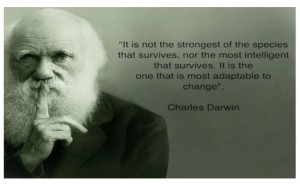
Leadership that makes a real difference can only show up when things get tough!
To exercise this kind leadership, we need to move beyond resilience and to achieve this, we need to build the adaptive capacity required to thrive in our increasingly demanding global economy, where hyper-complexity and adaptive challenges have become the new normal.
Resilience is only the foundation
That which does not kill us makes us stronger.
— Friedrich Nietzsche
It’s no coincidence that ‘resilience’ or ‘bouncing back’ from difficult experiences when faced with adversity, tragedy, trauma, threats or significant sources of stress (e.g. serious health problems, family and other relationship issues, financial or challenging workplace situations) has become a major topic of interest in recent times.
The individual approach
Regardless of role, industry, sector or culture, we all need to develop the individual resilience to respond effectively to adversity and potentially dangerous and high risk situations in order to survive. Strategies to develop this individual resilience fall into seven categories:
- Building, using and maintaining a close social network of relationships (e.g. family, friends and confidants);
- Maintaining a positive view of ourselves with confidence in our strengths and ability to cope (represented by the ‘optimism’, ‘positive psychology’, ‘mental toughness’ and ‘PsyCap’ wave);
- Effectively managing our feelings and strong impulses (epitomised by the ‘emotional intelligence’ – the EI or EQ – wave);
- Using effective problem-solving, conflict management and other social skills and feeling in control (embodied by the ‘social skills’ wave and further reinforced by the EI wave);
- Seeking help and resources and seeing ourselves as active participants rather than passive recipients and victims of our external environment and circumstances; (promoted by ‘humanistic psychology’ and the ‘self-help’ movement).
- Taking care of ourselves. This includes maintaining a healthy and balance life style, including good eating habits and physical exercise (the ‘life balance’ wave); and
- Using meditation and other spiritual practices to make meaningful connections, redefine our sense of identity and restore hope (represented by many ancient, yet re-emerging, traditions pioneered in recent times by people like the Dali Lama, Eckhart Tolle, Deepak Chopra, Oprah Winfrey, Ken Wilber and others).
Indeed, the ongoing practice of these seven strategies is critical to inoculate ourselves from, or to overcome, obstacles in our everyday life. Hence, they should be practiced and cultivated as they enable us to become stronger, wiser and more resilient – to survive and grow.
Limitations
The above mentioned approaches/strategies and associated techniques, however, have a strong individual focus. If you wish to seriously impact the wider system (e.g. your team, organisation, community or nation), they are insufficient. Effectively impacting your ‘system’ requires you to move from the ‘I’ (self-management and self-leadership) to the ‘we’ (adaptive and collective leadership).
Adaptive Leadership – The systemic and collective wave
Emerging from over thirty years of research at Harvard University by Dr. Ron Heifetz and Marty Linsky, Adaptive Leadership (AL) – “the practice of mobilizing people to tackle tough challenges and thrive” – is now defining a new frontier in leadership development. This approach is very much consistent with Peter Senge’s systems thinking rationale, including the notions of ‘interdependence’ and ‘collective intelligence’ as presented in his bestselling classic ‘The Fifth Discipline’. Adaptive Leadership is an approach for making progress on the most important challenges in our personal and professional lives by mobilising people towards a collective purpose that exists beyond our own individual ambitions.
The adaptive challenge
The term ‘adaptation’ derives from biology, biological adaptation or ‘survival of the fittest’:
Yes, it’s very simple: adapt or perish!
Successful adaptation requires three uncompromising phases:
- Preservation of the essential DNA required for the species to survive;
- Rejection or disposal of the DNA that no longer serves the current needs of the species; and
- Re-arrangement, mutation or genetic recombination that allows the permanent alteration of the DNA required for the species to effectively respond and flourish in the new, hostile and challenging environment.
Hence, the critical importance diversity has in not only the survival of the species but also the survival of organisations.
Diversity and inclusion in organisations
Diversity, when minorities form a critical mass and leaders value differences, unlocks innovation by creating an environment where ‘outside the box’ ideas are heard. In fact, we now have evidence that diversity and inclusion are the formula for success.
When organisations realise that their loftiest aspirations –the progress and innovations they want to achieve –cannot be reached using their traditional/current approaches, AL becomes the approach needed to diagnose, interrupt and create the capabilities the organisation needs to be able move to the next level. Hence, AL is purposeful evolution in real time.
Implications for organisations, communities, and their leadership
The adaptation described above also applies to organisations that want to stay relevant, adapt and survive. To this end, they need to alter their DNA (identity, primary task or purpose, image, culture and structures).
Dealing with such strategic shifts and transformations requires the emergence of leadership that:
- Reads and acts on the signs from the market before is too late. Companies such as Xerox, Motorola, Olivetti, Polaroid, Kodak , Nokia, Blackberry, MySpace, HP,, General Motors, Holden Motors, Sears, Blockbuster, Borders (and arguably the entire publishing industry) read the signs too late;
- Experiments to find ways that work best. Companies such as Ikea, Tesco, EBay, Amazon and Domino experimented with their new business models;
- Tolerates confusion and uncertainty and contains the anxiety of the system and the individuals within it arising from such challenges;
- Is tolerant of failure, and even willing to celebrate it;
- Takes the risk and admits that it ‘doesn’t know’ or ‘doesn’t have the solution’;
- Has the courage to name ‘the elephant in the room’;
- Is prepared to examine its own contribution to the problem, and is prepared give up its own priorities, beliefs, habits and loyalties;
- Takes itself, and others, to the frontiers of their incompetence to learn (and/or unlearn) that which is required to adapt and survive;
- Is prepared to push boundaries, defy the status quo and become disruptive as safely as possible; and
- Is aware of the risk of – and often prepared for– being blamed, sacrificed or crucified’ for being too disruptive.
Not surprisingly, adaptation (and AL) becomes the new source of competitive advantage. At the same time, AL is also a very risky and dangerous business!
The dangers of Adaptive Leadership
“To lead is to live dangerously because when leadership counts, when you lead people through difficult change, you challenge what people hold dear – their daily habits, tools, loyalties, and ways of thinking – with nothing more to offer perhaps than a possibility.
Moreover, leadership often means exceeding the authority you are given to tackle the challenge at hand. People push back when you disturb the personal and institutional equilibrium they know. And people resist in all kinds of creative and unexpected ways that can get you taken out of the game: pushed aside, undermined or eliminated.”
– Martin Linsky and Ronald Heifetz (2002)
“Leadership on the Line: Staying Alive through the Dangers of Leading”
The adaptive challenge is compelling
You probably have heard this before:
Up to 70% of all changes attempted in organisations fail.
or
Two years after undergoing coronary-artery bypass grafting,
up to 90% of patients have not changed their lifestyle.
Even though such patients know they have a life threatening disease, for whatever reason, they can’t make the required changes.
This is because many people still fail to distinguish between ‘technical’ vs ‘adaptive’ challenges. In fact, they actually treat adaptive challenges (those which require new learning and for people to change their ways to be addressed) as technical challenges (those which only require the knowledge of experts, routine problem solving, for which past ways of thinking and operating are sufficient).
Here are some common examples that, no doubt, you’ll be familiar with:
- Three simple steps to becoming a millionaire!
- Five easy steps to becoming happy and rich!
- Seven steps to losing weight or giving up smoking forever!
- Nine steps to successful change management!
- Ten steps to cultural change and organisational transformation!
- Twelve steps to self-transformation, Nirvana and becoming ten inches taller!
Not surprisingly, such ‘easy formula-based’ approaches are really successful – not necessarily for the end user, but more so for the seller of the formula. Yes, ‘hope’ is always in demand and is easy to sell.
Unfortunately, as Peter Senge and his colleagues, put it:
“Most change initiatives don’t fail because they lack hope, grand visions and noble intentions. They fail because people can’t see the reality they face”
Presence: Exploring Profound Change in People, Organizations and Society (p. 29)
And to discover the reality we face, we often need to change our mindset first.
“The real voyage of discovery consists not in seeking new landscapes, but in having new eyes.”
– Marcel Proust
Sebastian Salicru (Business Psychologist) | Leadership Development Expert, Executive Coach, Facilitator and Author | www.pts.net.au



